Miniaturized Patch Array Antenna Using CSRR Structures for 5G Millimeter-Wave Communication Systems
Abstract
1. Introduction
2. Proposed Antenna Design Process
2.1. Complementary Split-Ring Resonator Unit Cell Design
2.2. Array Design
2.3. Final Optimization Round
3. Simulation Results
Miniaturized Array Antenna
4. Experimental Results
5. Conclusions
Author Contributions
Funding
Data Availability Statement
Conflicts of Interest
References
- Sadeghi-Marasht, S.; Sharawi, M.S.; Zhu, A. Dual-Band Circularly Polarized Antenna Array for 5 G Millimeter-Wave Applications. IEEE Open J. Antennas Propag. 2022, 3, 314–323. [Google Scholar] [CrossRef]
- Saleh, C.M.; Almajali, E.; Jarndal, A.; Yousaf, J.; Alja’Afreh, S.S.; Amaya, R.E. Wideband 5G Antenna Gain Enhancement Using a Compact Single-Layer Millimeter Wave Metamaterial Lens. IEEE Access 2023, 11, 14928–14942. [Google Scholar] [CrossRef]
- Efri, S.; Rusmono, R.; Diamah, A.; Vinda, K. Ultra-wideband Microstrip Array Antenna for 5G Millimeter-wave Applications. J. Commun. 2020, 15, 198–204. [Google Scholar]
- Shen, X.; Liu, Y.; Zhao, L.; Huang, G.-L.; Shi, X.; Huang, Q. A Miniaturized Microstrip Antenna Array at 5G Millimeter-Wave Band. IEEE Antennas Wirel. Propag. Lett. 2019, 18, 1671–1675. [Google Scholar] [CrossRef]
- Bangash, K.; Ali, M.M.; Maab, H.; Ahmed, H. Design of a Millimeter Wave Microstrip Patch Antenna and Its Array for 5G Applications. In Proceedings of the 2019 International Conference on Electrical, Communication, and Computer Engineering (ICECCE), Swat, Pakistan, 13–14 July 2019. [Google Scholar]
- Frist, Y.; Elhabchi, M.; Srifi, M.N. A Novel Millimeter-Wave Miniaturized UWB Antenna Developed for 5G Applications Using Four L-Shaped and SRR Slots. In Proceedings of the 2023 6th International Conference on Advanced Communication Technologies and Networking (CommNet), Rabat, Morocco, 11–13 November 2023. [Google Scholar]
- Vinoth, M.; Vallikannu, R. Design and Analysis of Metamaterial Patch Antenna 5G and X Band Applications. In Proceedings of the 2021 International Conference on Computer Communication and Informatics (ICCCI), Coimbatore, India, 19–22 July 2021. [Google Scholar]
- Kumar, R.; De, A. Design of High Gain, Twin-band Antenna with CSRR for 5G Applications. In Proceedings of the 2022 IEEE Silchar Subsection Conference (SILCON), Silchar, India, 4–6 November 2022. [Google Scholar]
- Estu, T.T.; Murad, N.A.; Sugandi, G.; Praludi, T.; Yusoff, M.F.M.; Wijayanto, Y.N. Directive Beam Metamaterial Inspired Transparent Folded Dipole Antenna for Millimeter Wave Applications. In Proceedings of the 2023 International Conference on Radar, Antenna, Microwave, Electronics, and Telecommunications (ICRAMET), Bandung, Indonesia, 15–16 November 2023. [Google Scholar]
- Selvaraju, R.; Jamaluddin, M.H.; Kamarudin, M.R.; Nasir, J.; Dahri, M.H. Mutual Coupling Reduction and Pattern Error Correction in a 5G Beamforming Linear Array Using CSRR. IEEE Access 2018, 6, 65922–65934. [Google Scholar] [CrossRef]
- Nadzir, N.M.; Rahim, M.K.A.; Murad, N.A.; Himdi, M. Millimeter Wave Microstrip Antenna with CSRR for 5G Application. In Proceedings of the 2020 International Symposium on Antennas and Propagation (ISAP), Osaka, Japan, 25–28 January 2021. [Google Scholar]
- Sharma, G.; Kumar, M. SRR integrated CDRA Hybrid Antenna for 5G mm-Wave Communication. In Proceedings of the 2023 First International Conference on Microwave, Antenna and Communication (MAC), Prayagraj, India, 24–26 March 2023. [Google Scholar]
- Adiga, A.K.; Manjunath, A.K.; Giddegowda, Y.; Bhatkoorse, R. Gain Enhancement of 4 × 4 mm-Wave Patch Array with Dielectric Shells and Metamaterial Lens: A Comparative Study. IEEE Wirel. Antenna Microw. Symp. 2022, 1, 1–5. [Google Scholar]
- Nandigama, S.V.; Bharath, K.; Krishna, D.R. Gain Enhancement of an Aperture Coupled Antenna using Metasurface at mm-wave Frequency. In Proceedings of the 2021 IEEE Indian Conference on Antennas and Propagation (InCAP), Jaipur, Rajasthan, India, 13–16 December 2021. [Google Scholar]
- Khalily, M.; Tafazolli, R.; Xiao, P.; Kishk, A.A. Broadband mm-Wave Microstrip Array Antenna with Improved Radiation Characteristics for Different 5G Applications. IEEE Trans. Antennas Propag. 2018, 66, 4641–4647. [Google Scholar] [CrossRef]
- Mishra, P.; Komatineni, R.; Kulat, K.D. Millimeter Wave MPA using Metamaterial-Substrate Antenna Array for Gain Enhancement. In Proceedings of the 2023 National Conference on Communications (NCC), Guwahati, India, 23–26 February 2023. [Google Scholar]
- Chowdhury, A.; Ranjan, P. SRR and DGS-Based Highly Isolated Four-Port MIMO Antenna for Mid-5G Band and High-5G Band. MAPAN J. 2024, 39, 321–336. [Google Scholar] [CrossRef]
- Essid, C.; Samet, A. A Design of Phased Array Antenna with Metamaterial Circular SRR for 5G Applications. In Proceedings of the 28th IEEE Annual International Symposium on Personal, Indoor, and Mobile Radio Communications (PIMRC), Montreal, QC, Canada, 8–13 October 2017. [Google Scholar]
- Cai, X.; He, Y.; Xu, J.; Qin, K.; Luo, Y. A Dual-Band Millimeter-Wave Antenna Loaded with CSRR. In Proceedings of the International Applied Computational Electromagnetics Society Symposium (ACES), Beijing, China, 8–11 April 2019. [Google Scholar]
- Ameen, A.M.; Yousef, B.M.; Attiya, A.M. Mutual Coupling Reduction Between MM-Wave Microstrip Antennas Using CSRR Metamaterial Structure. In Proceedings of the 37th National Radio Science Conference (NRSC), Cairo, Egypt, 25–27 August 2020. [Google Scholar]
- Rappaport, T.S.; Sun, S.; Mayzus, R.; Zhao, H.; Azar, Y.; Wang, K.; Wong, G.N.; Schulz, J.K.; Samimi, M.; Gutierrez, F. Millimeter Wave Mobile Communications for 5G Cellular: It Will Work! IEEE Access 2013, 1, 335–349. [Google Scholar] [CrossRef]
- Bai, T.; Heath, R.W. Coverage and Rate Analysis for Millimeter-Wave Cellular Networks. IEEE Trans. Wirel. Commun. 2015, 14, 1100–1114. [Google Scholar] [CrossRef]
- Niu, Y.; Li, Y.; Jin, D.; Su, L.; Vasilakos, A.V. A Survey of Millimeter Wave Communications (mmWave) for 5G: Opportunities and Challenges. Wirel. Netw. 2015, 21, 2657–2676. [Google Scholar] [CrossRef]
- MacCartney, G.R.; Rappaport, T.S.; Samimi, M.K.; Sun, S. Millimeter-Wave Wireless Communications: New Results for Rural Connectivity. IEEE J. Sel. Areas Commun. 2017, 35, 1663–1677. [Google Scholar] [CrossRef]
- Yeh, C.H.; Chien, H.C.; Wu, Y.F.; Chow, C.W.; Chi, S.; Tsai, H.M. Performance Evaluation of 28-GHz Millimeter-Wave Wireless Access Networks for Satellite Communications. IEEE Trans. Veh. 2018, 67, 1227–1235. [Google Scholar]
- Akyildiz, I.F.; Jornet, J.M.; Han, C. Terahertz Band: Next Frontier for Wireless Communications. Phys. Commun. 2014, 12, 16–32. [Google Scholar] [CrossRef]
- Skolnik, M.I. Radar Handbook, 3rd ed.; McGraw-Hill: New York, NY, USA, 2008. [Google Scholar]
- Patole, S.M.; Torlak, M.; Wang, D.; Ali, M. Automotive Radar: A Review of Signal Processing Techniques. IEEE Signal Process. Mag. 2017, 34, 22–35. [Google Scholar] [CrossRef]
- Ghosh, A.; Thomas, T.A.; Cudak, M.C.; Ratasuk, R.; Moorut, P.; Vook, F.W.; Rappaport, T.S.; Sun, S. Millimeter-Wave Enhanced Local Area Systems: A High-Data-Rate Approach for Future Wireless Networks. IEEE J. Onselected Areas Commun. 2014, 32, 1152–1163. [Google Scholar] [CrossRef]
- Wild, T.; Tonn, K. 5G with Fixed Wireless Access: Fixed Wireless Access Solutions for 5G. In Ericsson White Paper; Ericsson: Stockholm, Sweden, 2020. [Google Scholar]
- Sadeghi, M.; Sadigh, A.K.; Rasti, M.; Pakravan, M.R. Wireless Communications and IoT for Smart Industry. IEEE Internet Things J. 2020, 7, 3991–4002. [Google Scholar]
- Palattella, M.R.; Dohler, M.; Grieco, A.; Rizzo, G.; Torsner, J.; Engel, T.; Ladid, L. Internet of Things in the 5G Era: Enablers, Architecture, and Business Models. IEEE J. Onselected Areas Commun 2016, 34, 510–527. [Google Scholar] [CrossRef]
- Shajaiah, H.; Abdel-Hadi, A.; Clancy, C. Overview of Spectrum Sharing Techniques for 5G Wireless Networks. IEEE Wirel. Commun. 2017, 24, 72–79. [Google Scholar]
- Boccardi, F.; Heath, R.W.; Lozano, A.; Marzetta, T.L.; Popovski, P. Five Disruptive Technology Directions for 5G. IEEE Commun. Mag. 2014, 52, 74–80. [Google Scholar] [CrossRef]
- Chakareski, J. VR/AR Immersive Communication: Caching, Edge Computing, and Transmission Trade-Offs. IEEE Commun. Mag. 2018, 56, 98–103. [Google Scholar]
- Fettweis, G.; Alamouti, S. 5G: Personal Mobile Internet Beyond What Cellular Did to Telephony. IEEE Commun. Mag. 2014, 52, 140–145. [Google Scholar] [CrossRef]
- Khan, W.Z.; Xiang, Y.; Aalsalem, M.Y.; Arshad, Q. IoT-Based Smart Healthcare: Key Applications and Challenges. IEEE Access 2018, 6, 62230–62250. [Google Scholar]
- Ghasempour, Y.; da Silva, C.R.C.M.; Knightly, E.W. Millimeter-Wave Communication for Wireless Virtual Reality: A Measurement Study. IEEE Trans. Wirel. Commun. 2021, 20, 5653–5669. [Google Scholar]
- Hayat, S.; Yanmaz, E.; Muzaffar, R. Survey on Antenna Technologies for 5G mmWave UAV Networks. IEEE Commun. Surv. Tutor. 2020, 22, 1912–1940. [Google Scholar]
- Fotouhi, A.; Qiang, H.; Ding, M.; Hassan, M.; Giordano, L.G.; Garcia-Rodriguez, A.; Yuan, J. Survey on UAV Cellular Communications: Practical Aspects, Standardization Advancements, Regulation, and Security Challenges. IEEE Commun. Surv. Tutor. 2019, 21, 3417–3442. [Google Scholar] [CrossRef]
- Andrews, J.G.; Buzzi, S.; Choi, W.; Hanly, S.V.; Lozano, A.; Soong, A.C.K.; Zhang, J.C. What Will 5G Be? IEEE J. Onselected Areas Commun. 2014, 32, 1065–1082. [Google Scholar] [CrossRef]
- Parkvall, S.; Dahlman, E.; Furuskar, A.; Frenne, M. NR: The New 5G Radio Access Technology. IEEE Commun. Stand. Mag. 2017, 1, 24–30. [Google Scholar] [CrossRef]
- Zanella, A.; Bui, N.; Castellani, A.; Vangelista, L.; Zorzi, M. Internet of Things for Smart Cities. IEEE Internet Things J. 2014, 1, 22–32. [Google Scholar] [CrossRef]
- Xu, Y.; Yuen, C.; Lin, X.; Jin, S. Smart Cities: Edge Computing and AI-Driven Data Processing. IEEE Commun. Mag. 2020, 58, 38–43. [Google Scholar]
- Wei, W.B. Automatic measurement of complex dielectric constant and permeability at microwave frequencies. In Proceedings of the IEEE; IEEE: New York, NY, USA, 1974; Volume 62, pp. 33–36. [Google Scholar]
- Samuel, P.J.C.; Nagarajan, G. Dual-Band Complementary Split-Ring Resonator Engraved Rectangular Monopole for GSM and WLAN/WiMAX /5G Sub-6 GHz Band (New Radio Band). Prog. Electromagn. Res. C 2021, 113, 251–263. [Google Scholar]
- Nupur, S.; Kr, G.N.; Kartikeyan, M.V. Metamaterial inspired CSSRR design for WLAN microstrip patch antenna. In Proceedings of the 11th International Conference on Industrial and Information Systems (ICIIS), Roorkee, India, 3–4 December 2016. [Google Scholar]
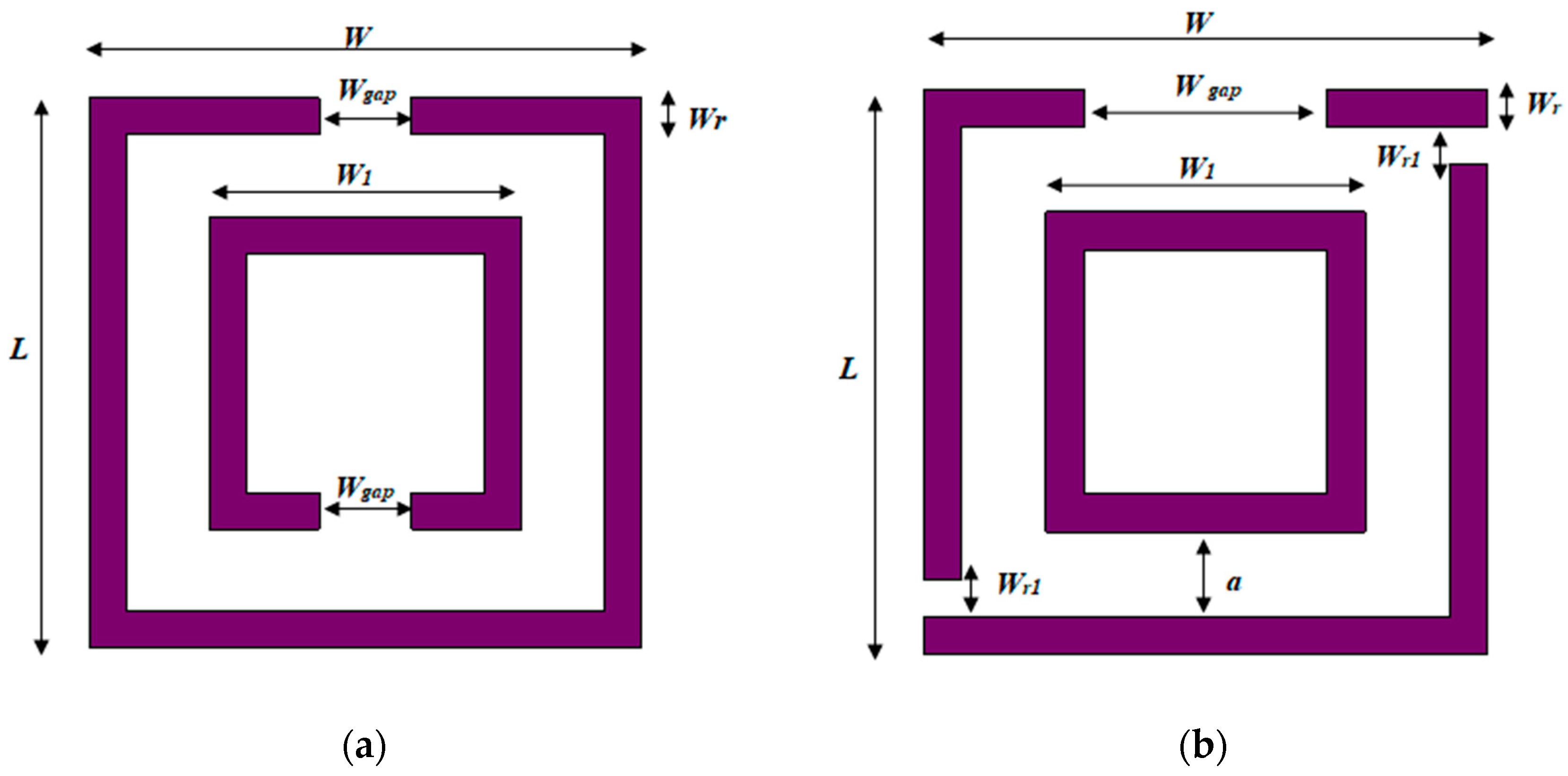
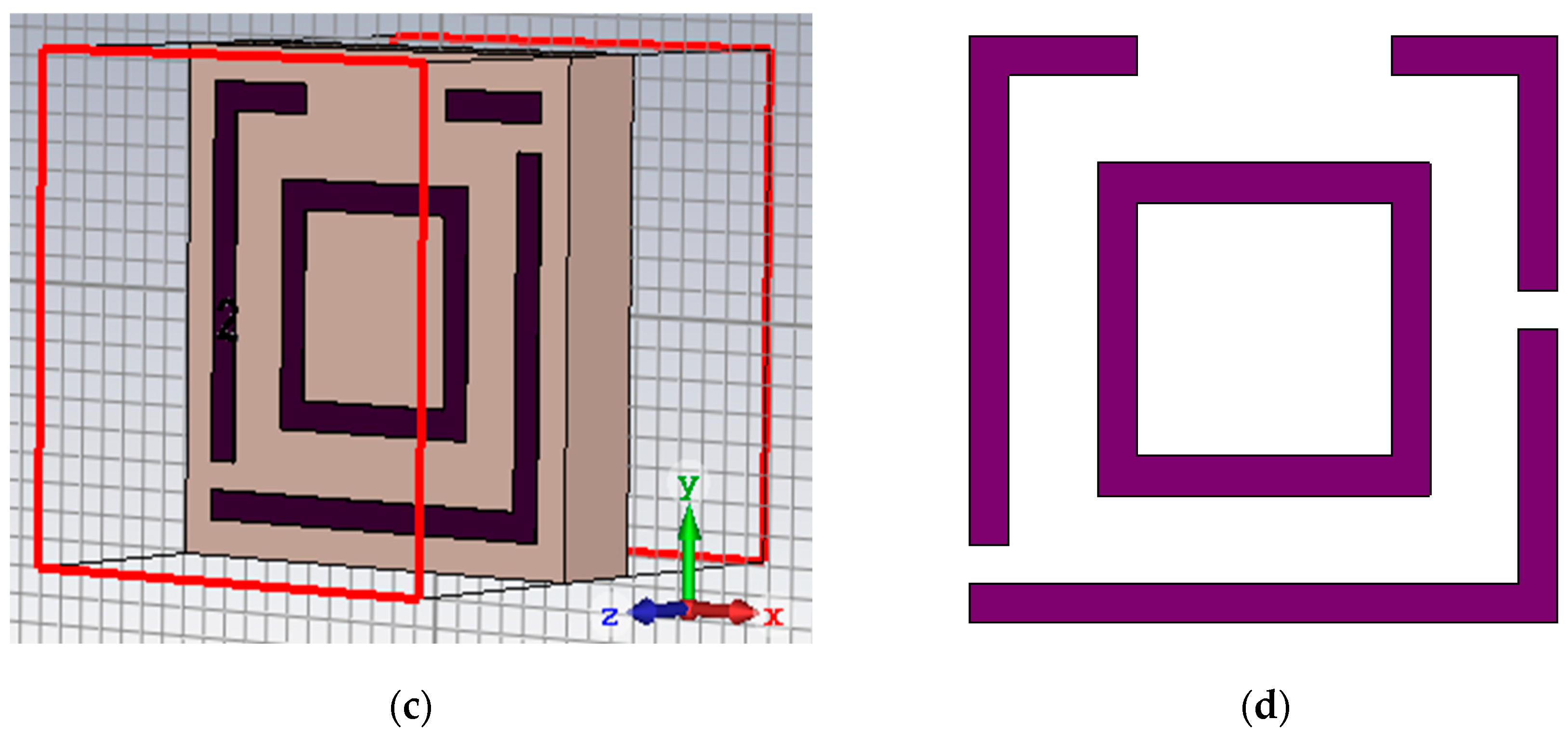
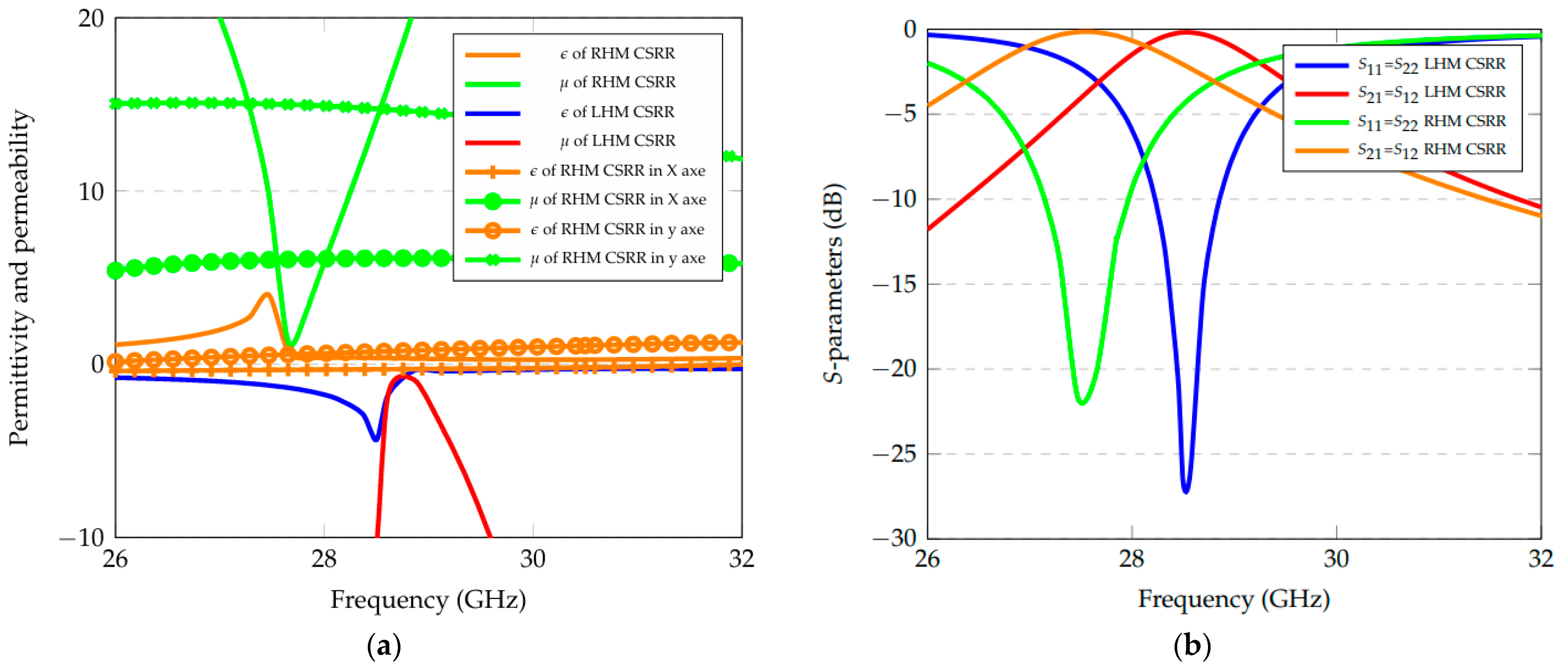
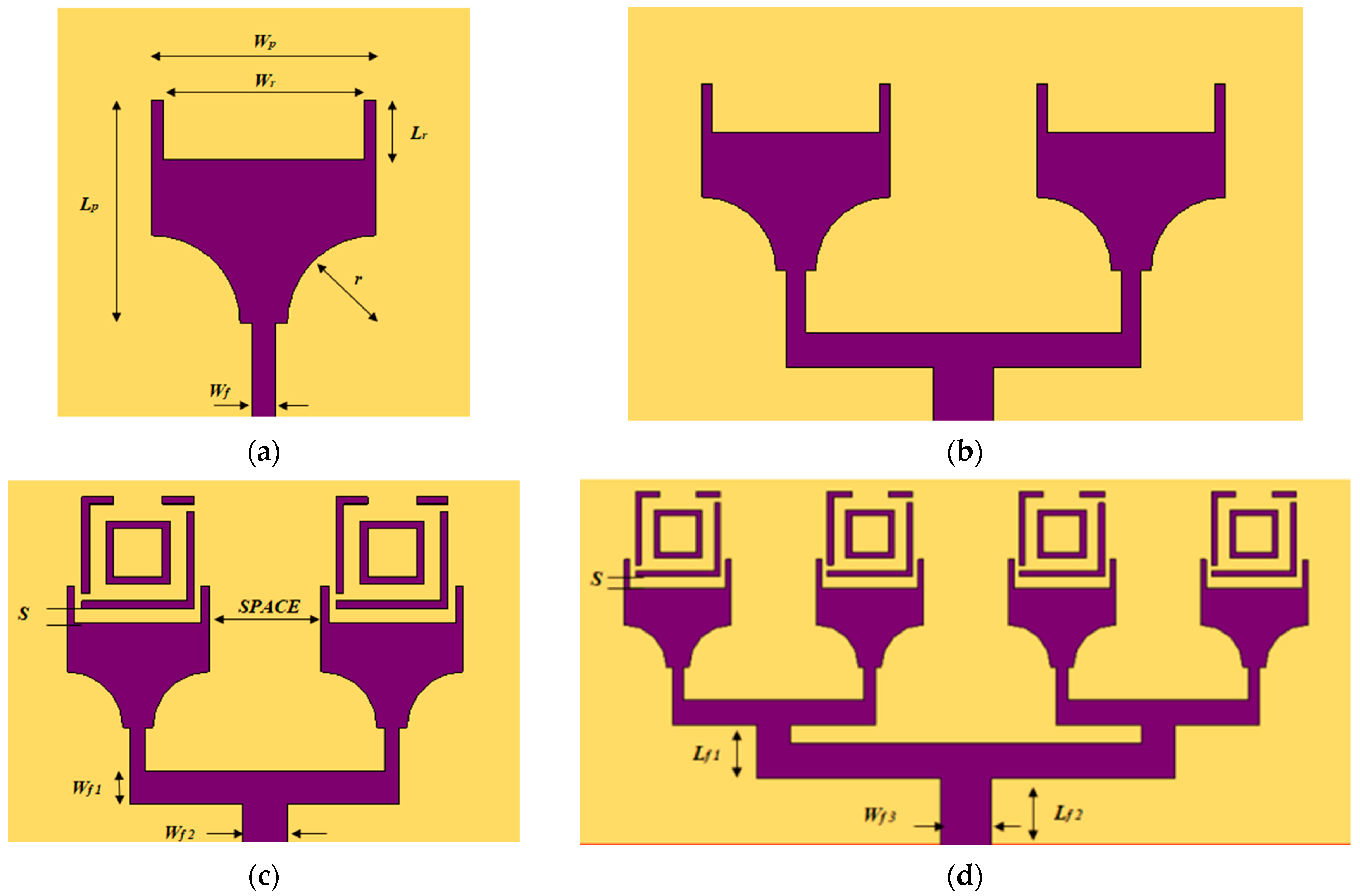
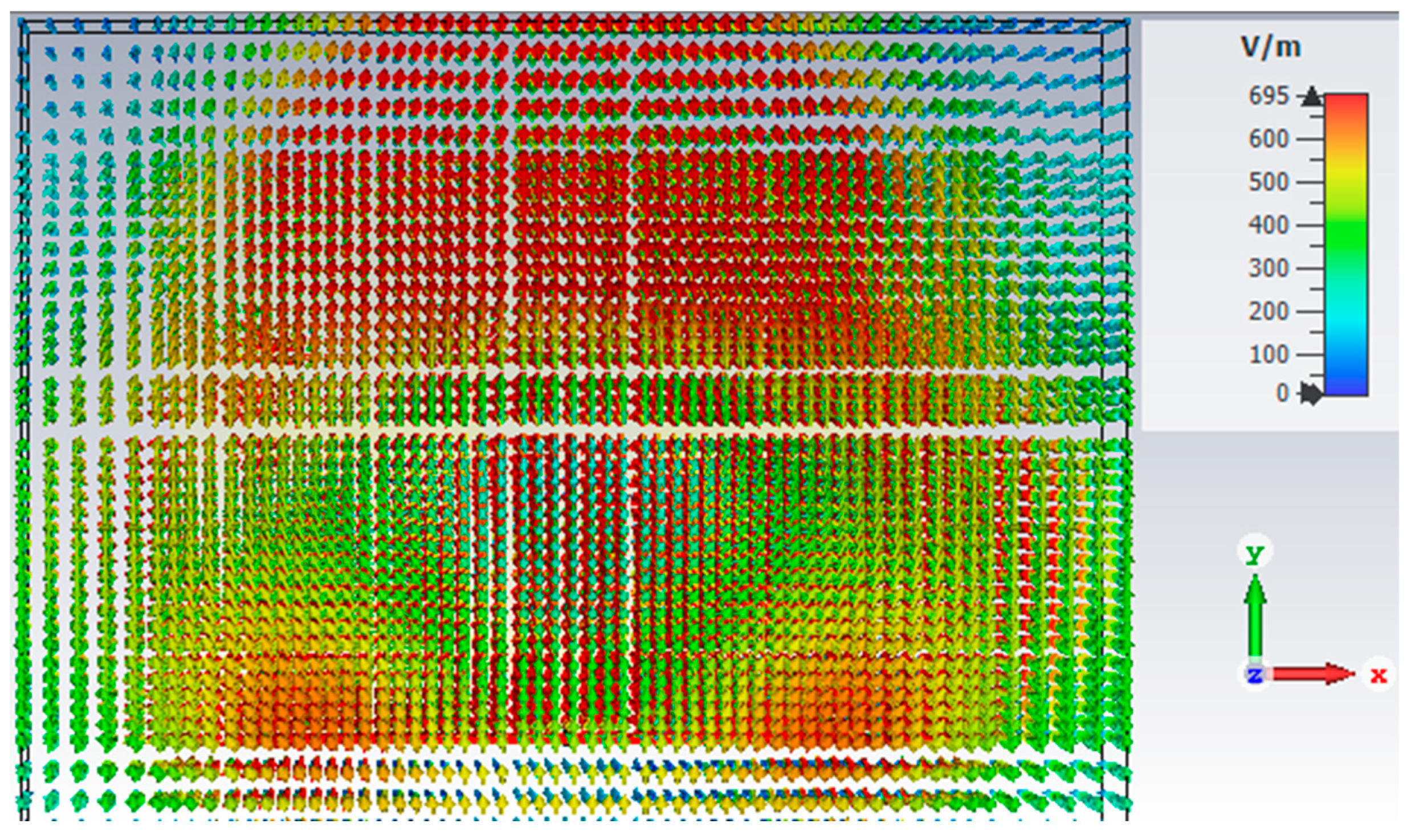
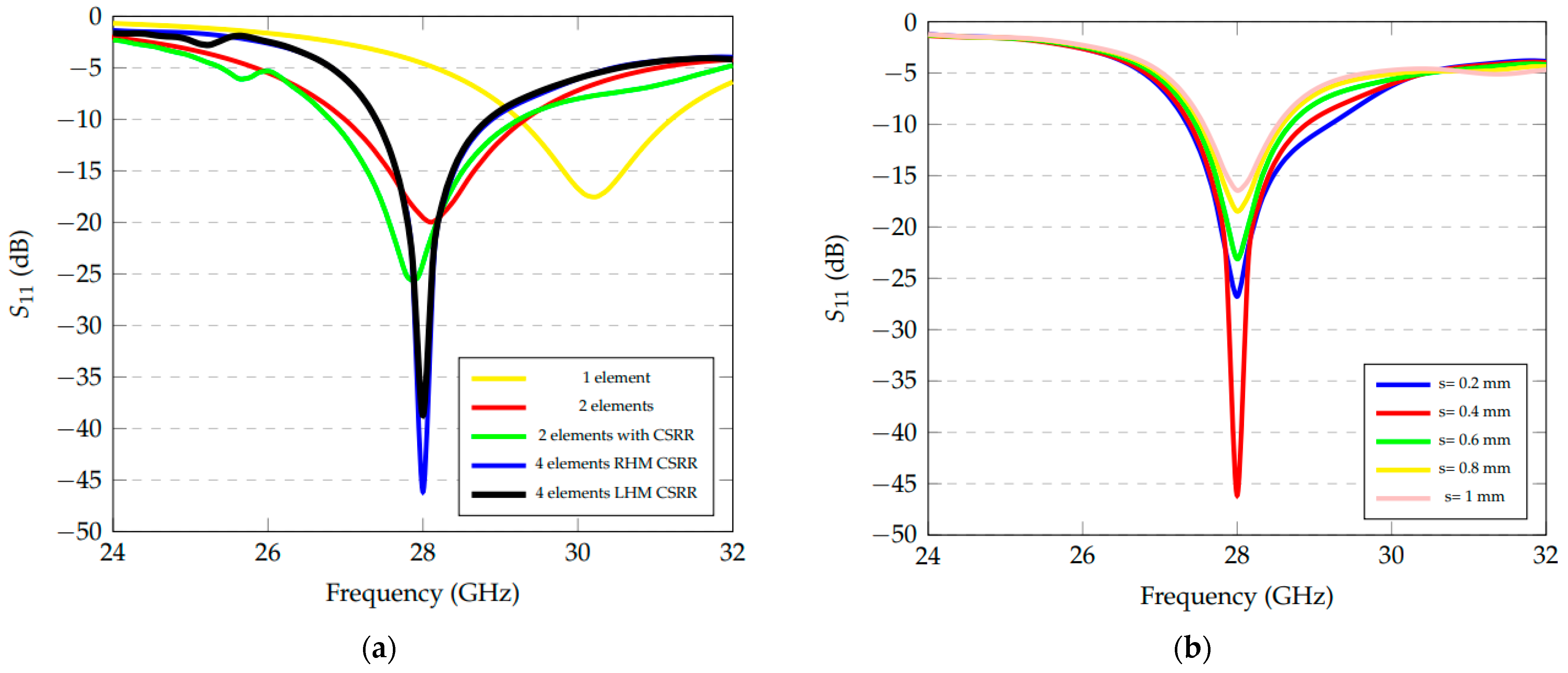
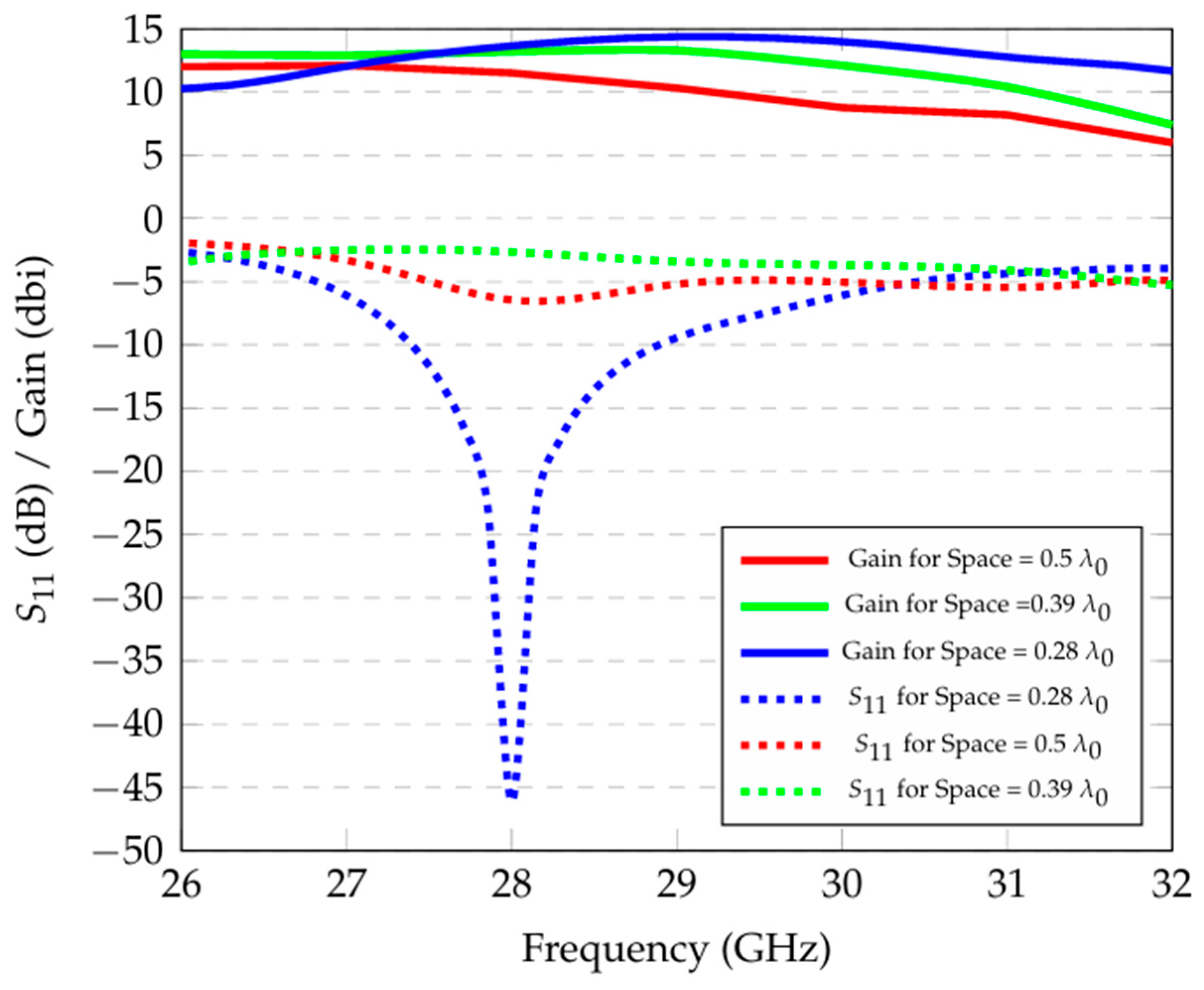


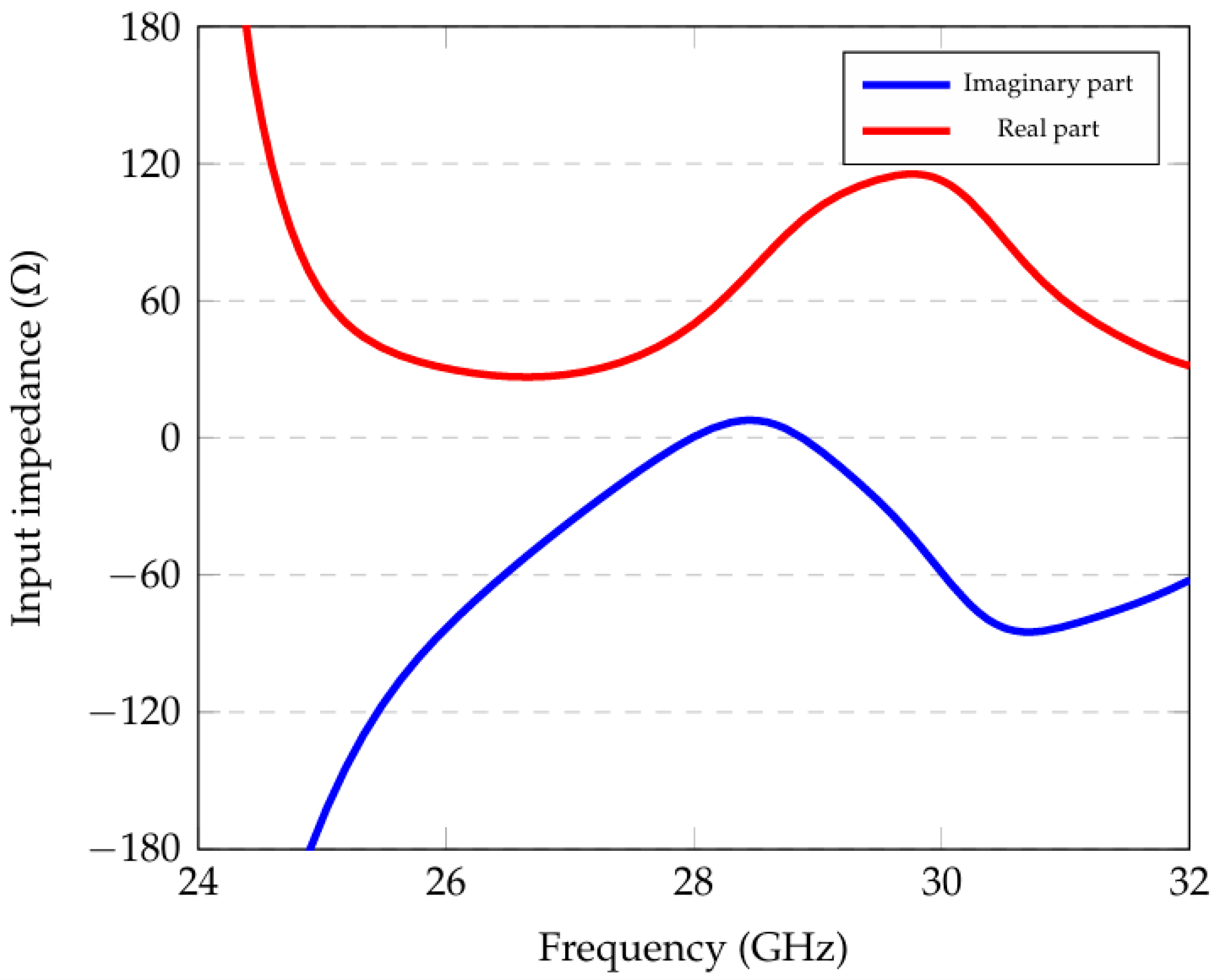
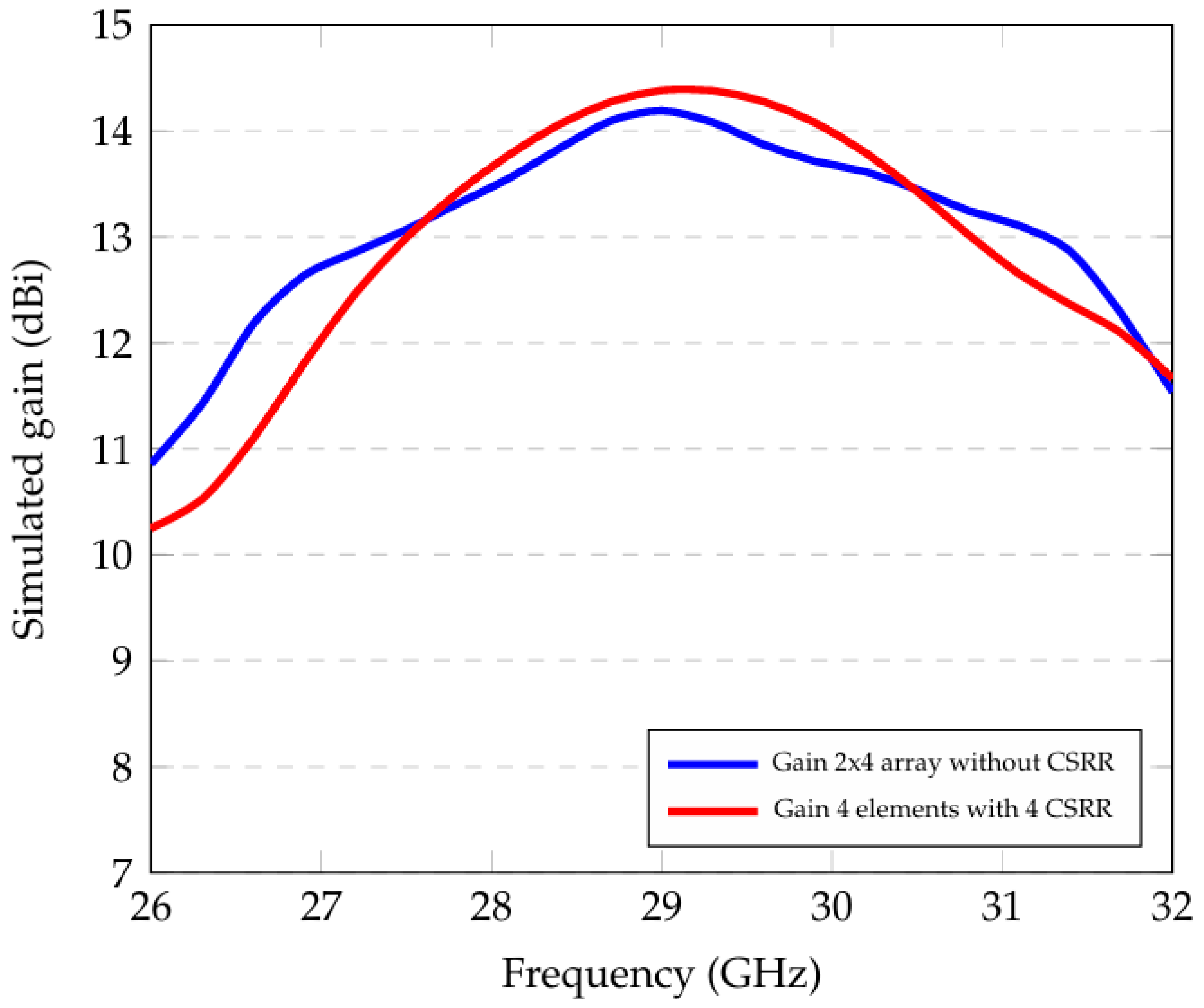
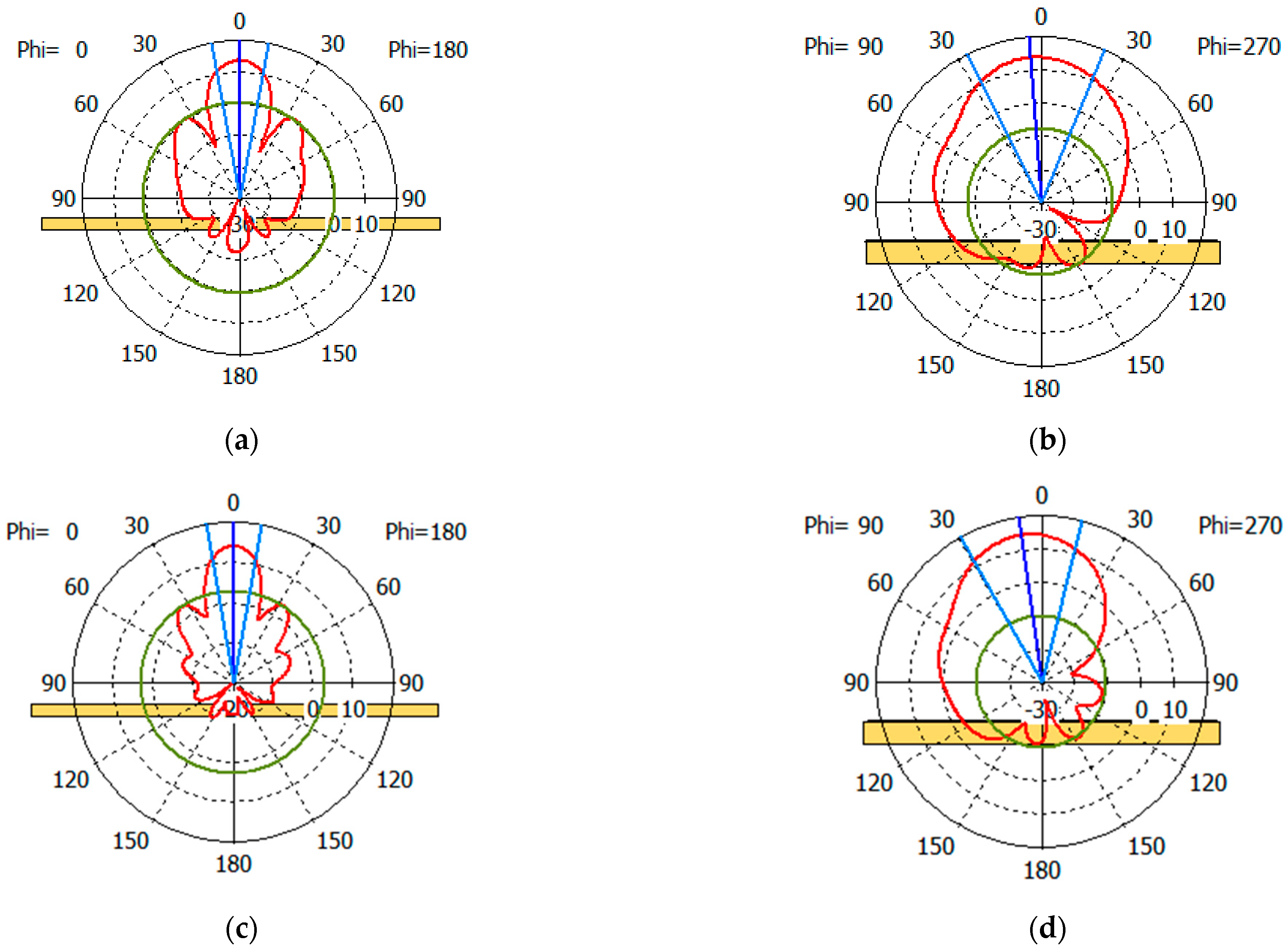
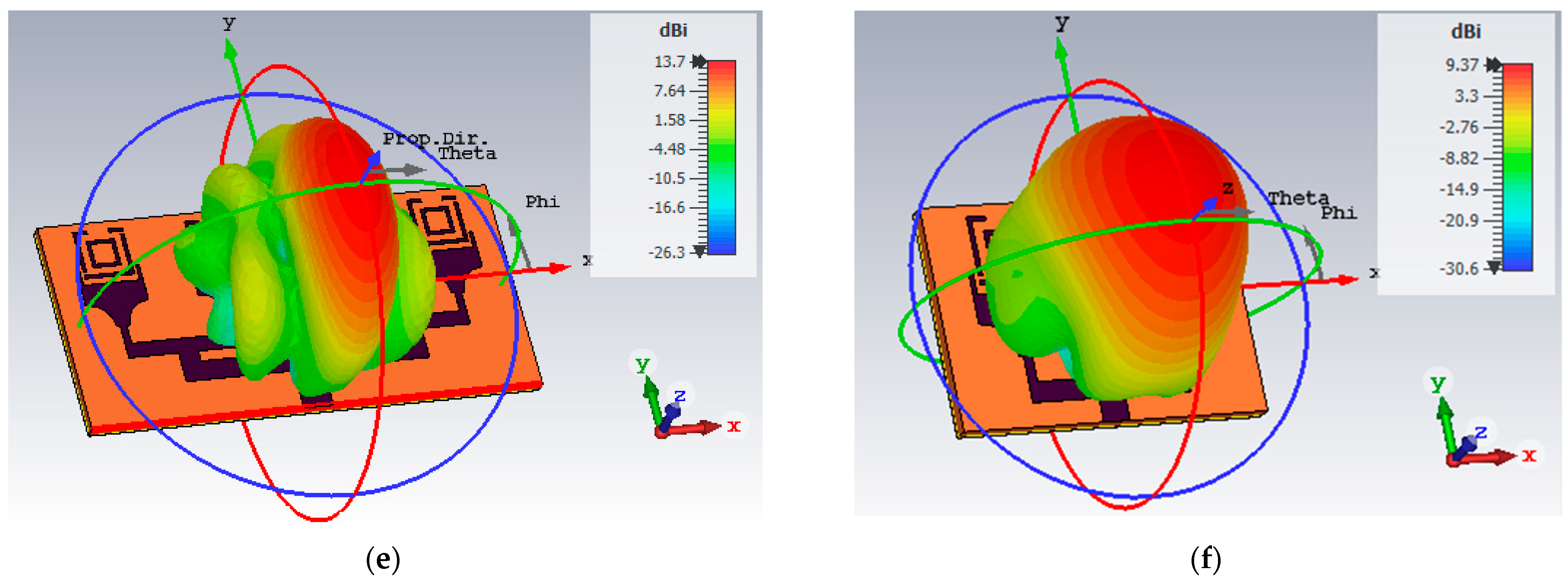

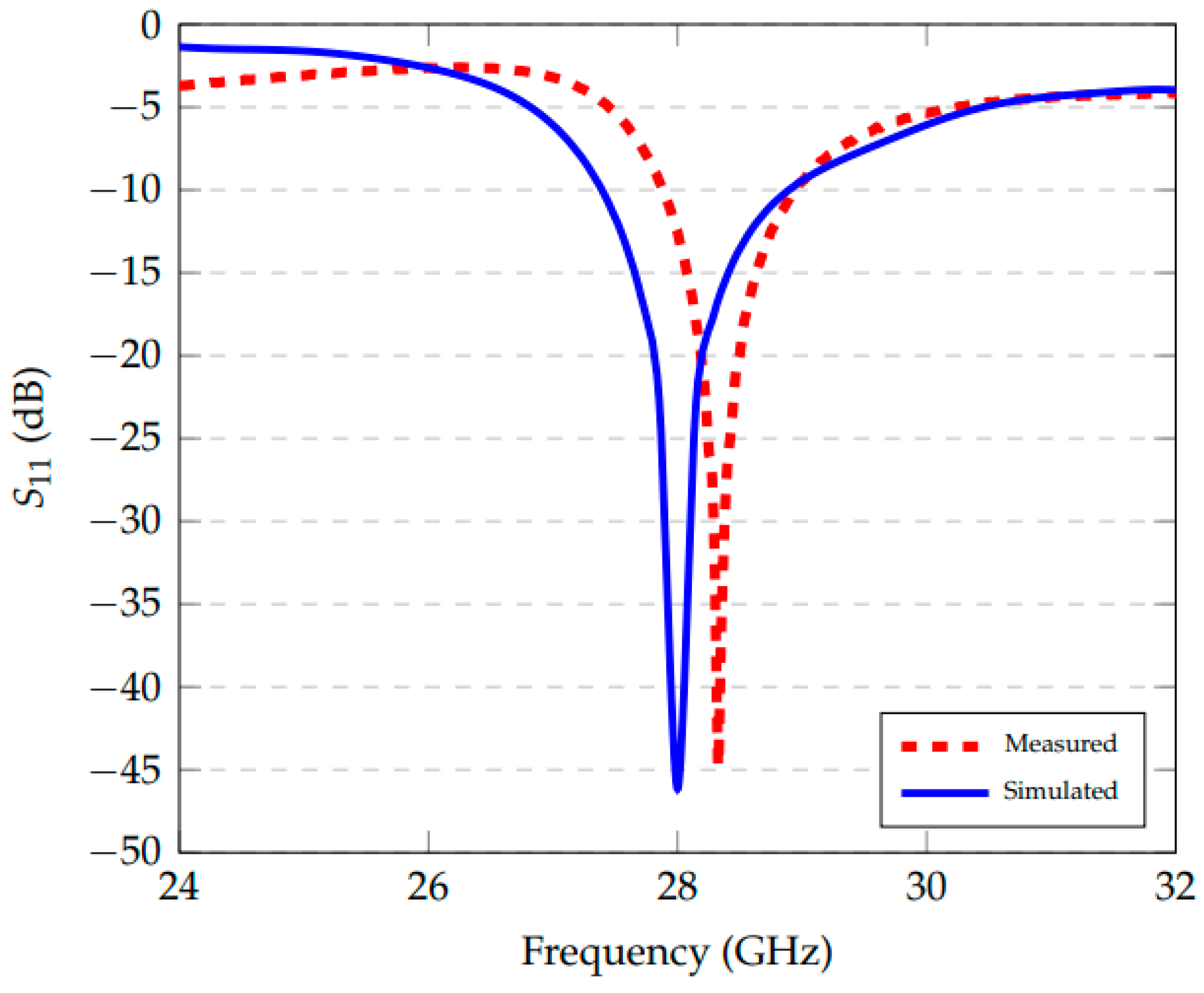
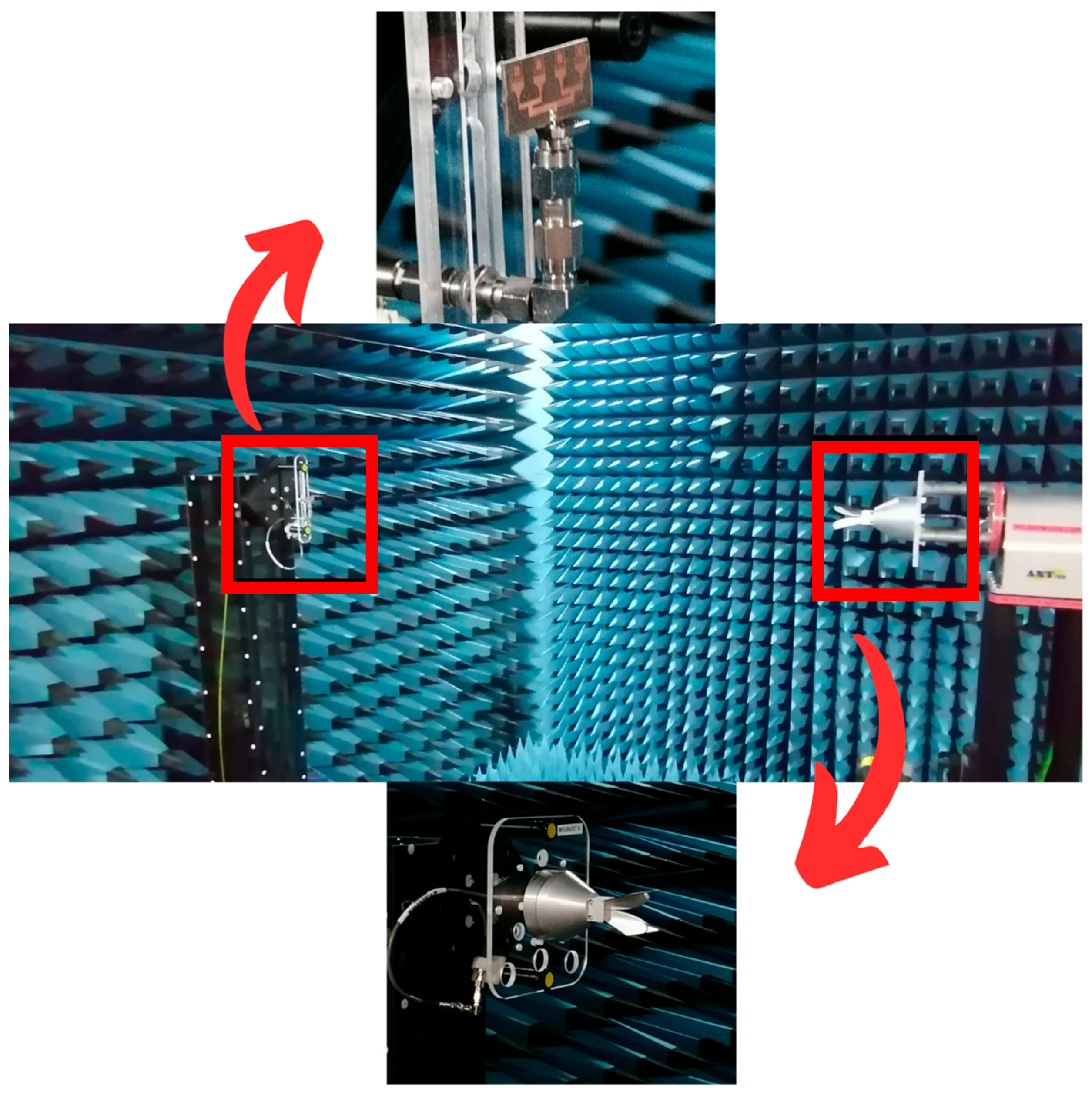
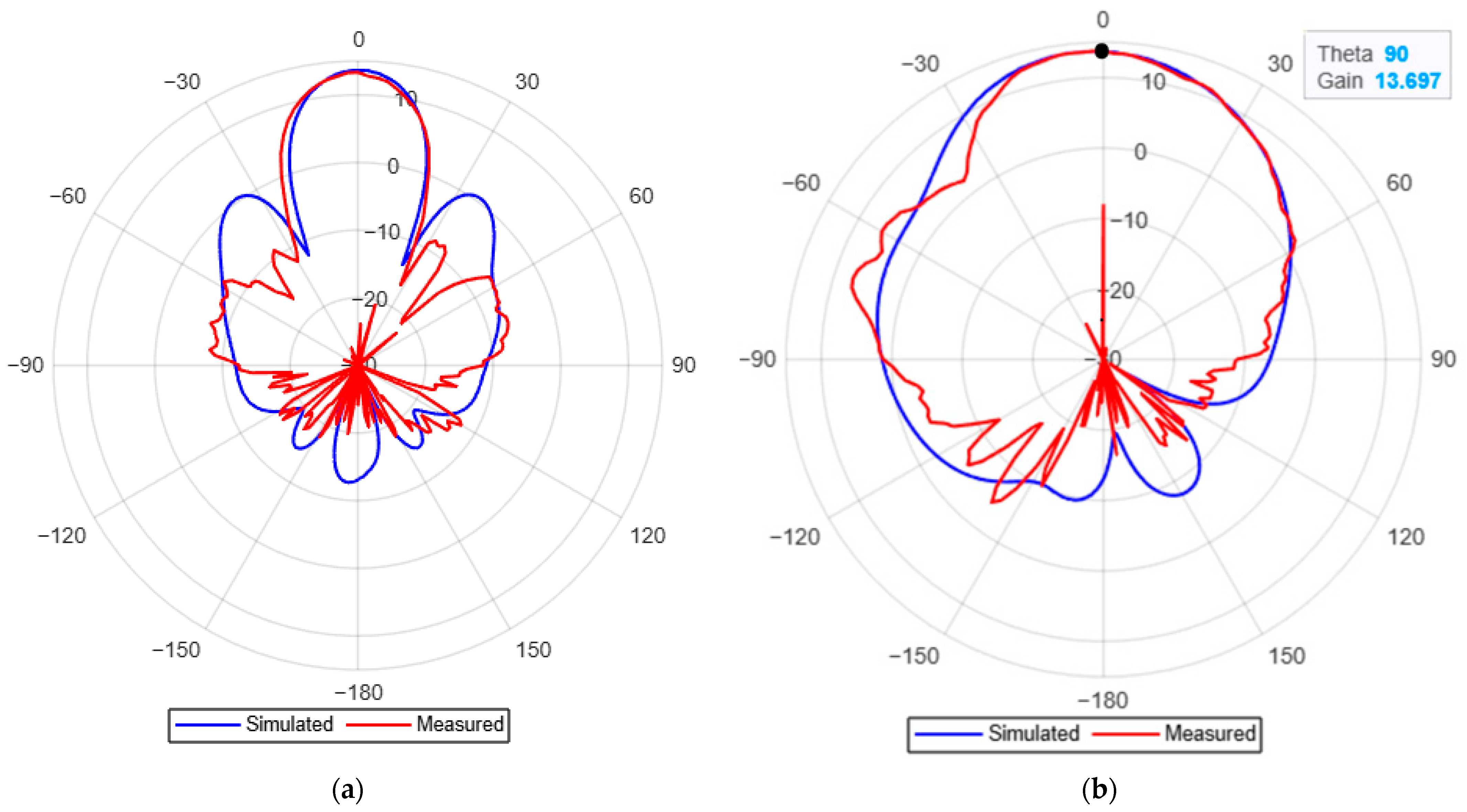

| Application | Antenna Gain (dBi) | Bandwidth (GHz) | S11 (dB) | Compactness | References |
|---|---|---|---|---|---|
| 5G Networks | 15 to 25 | 1 to 2 | <−15 | Moderate to High | [21,22] |
| Fixed Wireless Access (FWA) | 20 to 30 | 0.5 to 2 | <−10 | Moderate | [23,24] |
| Satellite Communication | 25 to 40 | 0.5 to 2 | <−15 | Low to Moderate | [25,26] |
| Radar Systems | 20 to 35 | 1 to 5 | <−10 | Moderate | [27,28] |
| Wireless Backhaul | 25 to 35 | 0.5 to 2 | <−15 | Moderate | [29,30] |
| Industrial IoT | 10 to 20 | 0.5 to 1 | <−10 | High | [31,32] |
| Point-to-Point Communication | 20 to 30 | 1 to 2 | <−10 | Moderate | [33,34] |
| AR/VR | 10 to 20 | 1 to 2 | <−10 | High | [35,36] |
| Healthcare | 6 to 15 | 0.5 to 1 | <−10 | Very High | [37,38] |
| UAVs (Drones) | 15 to 25 | 1 to 2 | <−10 | Moderate | [39,40] |
| Broadcasting | 20 to 30 | 1 to 2 | <−10 | Moderate | [41,42] |
| Smart Cities | 10 to 20 | 0.5 to 1 | <−10 | High | [43,44] |
| Parameter | Optimized Value (mm) |
|---|---|
| W | 3.0 |
| L | 3.0 |
| W1 | 1.7 |
| W gap | 1.3 |
| Wr | 0.2 |
| Wr1 | 0.2 |
| a | 0.45 |
| Copper Thickness | 0.017 |
| Parameter | Initial Value (mm) | Optimized Value (mm) |
|---|---|---|
| Wp | 4.34 | 3.80 |
| Lp | 4.34 | 3.80 |
| Wg | 9.062 | / |
| Lg | 9.062 | / |
| Wf | 0.4 | 0.4 |
| r | 0.2 | 1.5 |
| Wr | 3 | 3.4 |
| Lr | 0.6 | 1.0 |
| space | λ0/2 = 5.36 | 3.0 |
| r | 1 | 1.5 |
| Wf1 | 0.8 | 1.0 |
| Wf2 | 1.6 | 1.2 |
| Lf1 | 1.8 | 1.85 |
| Wf3 | 2 | 1.8 |
| Lf2 | 2 | 2.4 |
| S | 1 | 0.4 |
| substrate thickness | 0.787 | 0.787 |
| copper thickness | 0.017 | 0.017 |
| Antenna | Size (mm2) | Frequency (GHz) | Gain (dBi) Simulated/ Measured | Beamwidth (°) E-Plane/ H-Plane | Bandwidth (GHz) Simulated/ Measured | S11 (dB) Simulated/ Measured | Efficiency (%) Simulated/ Measured |
|---|---|---|---|---|---|---|---|
| [1] | 16.05 × 20 | 28 | 12/12.6 | 32 | 5.6 | −20/ | 90 |
| [2] | 12.8 ×12.8 | 26.5 | 13/12.7 | / | 6 | −22/−22 | 92 |
| [3] | 20 × 20 | 28 | 8.71 | / | 4.47 | −20/−20 | / |
| [4] | / | 28 | 7 | / | 6 | −40 | / |
| [5] | 10 × 10 | 24.85 | 13 | / | 1.3 | −19.5 | / |
| [6] | 12 × 10 | 28 | 5.79 | / | 26–75 | −40 | / |
| [7] | 4.6 × 4.6 | 19.04 | 3 | / | 0.2 | −23 | 88 |
| [8] | 3.2 × 4.23 | 27.3 | 7.25 | / | 1 | −30 | 96.5 |
| [9] | / | 28 | 7.2 | / | 6 | −25 | / |
| [10] | 32 × 8.6 | 25 | / | / | 1 | −40 | / |
| [11] | 36 × 35 | 28 | 13.3 | / | 2.2 | −25 | / |
| [12] | 5 × 5 | 28 | 4.07 | / | 0.9 | −25 | 97 |
| [13] | 20 × 20 | 24 | 17.3 | / | / | −35.18 | / |
| [14] | 28 × 28 | 27 | 7.8 | / | 1 | −39 | / |
| [15] | 17.45 × 99.2 | 28 | 18.7 | 49.5 | 6 | −15 | 86 |
| [16] | 18 × 22 | 28.5 | 14 | / | 10.4 | −40 | / |
| [17] | 60 × 60 | 28 | 4.50 | / | 3.0 | −30 | / |
| [18] | 13 × 52.87 | 28 | 2.83 | / | 8.0 | −30 | / |
| [19] | 9.2 × 6.8 | 28 | 5.80 | / | 3.8 | −20 | / |
| [20] | 8.7 × 17 | 25 | 10.00 | / | 1.6 | −31 | / |
| Our results | 27.40 × 13 | 28 | 13.7/13.7 | 20/49 | 1.5/1 | −45/−44 | 97/96 |
Disclaimer/Publisher’s Note: The statements, opinions and data contained in all publications are solely those of the individual author(s) and contributor(s) and not of MDPI and/or the editor(s). MDPI and/or the editor(s) disclaim responsibility for any injury to people or property resulting from any ideas, methods, instructions or products referred to in the content. |
© 2025 by the authors. Licensee MDPI, Basel, Switzerland. This article is an open access article distributed under the terms and conditions of the Creative Commons Attribution (CC BY) license (https://creativecommons.org/licenses/by/4.0/).
Share and Cite
Zerrouk, A.; Tounsi, M.L.; Vuong, T.P.; Corrao, N.; Yagoub, M.C.E. Miniaturized Patch Array Antenna Using CSRR Structures for 5G Millimeter-Wave Communication Systems. Electronics 2025, 14, 1834. https://doi.org/10.3390/electronics14091834
Zerrouk A, Tounsi ML, Vuong TP, Corrao N, Yagoub MCE. Miniaturized Patch Array Antenna Using CSRR Structures for 5G Millimeter-Wave Communication Systems. Electronics. 2025; 14(9):1834. https://doi.org/10.3390/electronics14091834
Chicago/Turabian StyleZerrouk, Abderraoufe, Mohamed Lamine Tounsi, Tan Phu Vuong, Nicolas Corrao, and Mustapha C. E. Yagoub. 2025. "Miniaturized Patch Array Antenna Using CSRR Structures for 5G Millimeter-Wave Communication Systems" Electronics 14, no. 9: 1834. https://doi.org/10.3390/electronics14091834
APA StyleZerrouk, A., Tounsi, M. L., Vuong, T. P., Corrao, N., & Yagoub, M. C. E. (2025). Miniaturized Patch Array Antenna Using CSRR Structures for 5G Millimeter-Wave Communication Systems. Electronics, 14(9), 1834. https://doi.org/10.3390/electronics14091834







